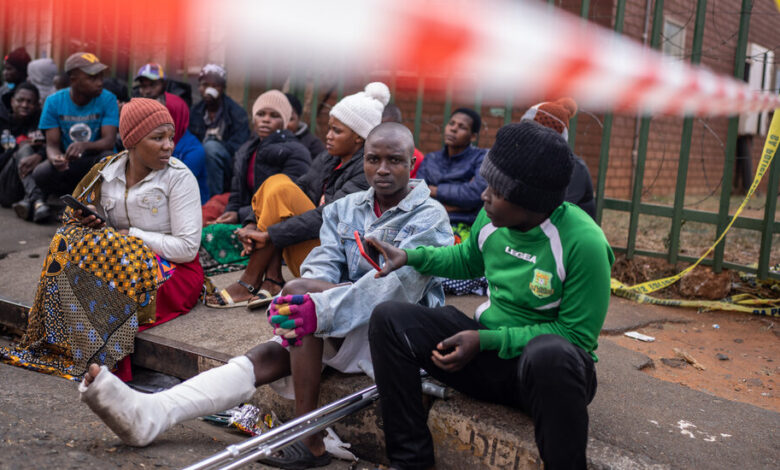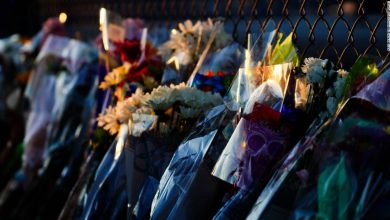Filthy Toilets, No Showers and Criminal Landlords: Life in a South African Firetrap

As Tom Mandala leaned out the fifth-floor window of his burning apartment building in Johannesburg early Thursday, it felt as if the only decision left to make was how to die.
He could turn around and dash for the stairs, but he would surely be overcome by the thick smoke and scorching flames, he figured. Or he could leap out the window and end up splattered on the sidewalk below.
The second option, he thought, would be the best way to ensure that his family back in Malawi would be able to recover his body. So, after about five minutes of agonizing deliberation, Mr. Mandala, 26, jumped.
“I was thinking nothing,” he said of the moment when he soared through the air.
Landing square on his feet sent a rush of pain up his legs so sharp that tears began to flow, he said. His right ankle was broken, and his left leg badly injured. But he was alive.
A sprawling, dilapidated building in downtown Johannesburg that was once a haven for battered women and children turned into a chaotic inferno on Thursday after a fire that killed at least 74 people forced residents into a desperate scramble to save themselves. They sprang from windows, banged on metal gates and shimmied down sheets that hung like ropes.
While the police and search dogs pursued the grim search for bodies, health officials on Friday urged people to come forward to identify their relatives at a mortuary, the last unclaimed bodies among the 64 victims who have been identified so far. Ten other bodies were burned beyond recognition, the officials said, and would be identified through DNA tests.
And as those official processes played out, more details emerged about the horrific conditions inside the illegally occupied building.
It was a port of last resort for hundreds of struggling South Africans and immigrants searching for a break in one of Africa’s most advanced economies. Criminals “hijacked” the building and extorted “rent” from the homeless and working poor who could not afford formal housing, officials have said.
Residents had long feared that the city-owned dwelling — with its maze of steel security doors, a courtyard lined with tin shacks and subdivided rooms — was a death trap. While the cause of the fire is still undetermined, those fears played out with terrifying velocity shortly after 1 a.m. Thursday when the first flames and whiffs of smoke jolted residents awake.
Kwazi Cele’s eldest daughter was up studying for her final high school exams when she heard a commotion in the hallway. She initially thought it was just people fighting, as usual. But when she poked her head out of their apartment, smoke billowed in, Ms. Cele said.
Their unit was at the end of the hallway, and Ms. Cele, 39, and her three children and niece tried to push their way toward the stairwell. But what seemed like hundreds of people clogged the hallway, she said, so they raced back into their third-floor unit, which, to their good fortune, was located just above the corrugated iron roof of the entryway. Ms. Cele said she hung a blanket out of the window, and she and her family climbed down. Dozens of other residents followed, she said.
“The state of the building did indicate that at one point or the other, we will experience something bad,” she said. “It’s just that we never knew that it would be this bad.”
Ms. Cele, a freelance makeup artist, moved into the building five years ago as a client of a shelter for women and children that was run by a nonprofit organization. When the nonprofit left in 2019, Ms. Cele said, men from an adjacent informal settlement began swarming the building, charging rents ranging from $32 a month to nearly $100. The conditions deteriorated rapidly, she said.
Power and sewer services were cut by the city, so residents set up illegal electricity and water connections. Showers in communal bathrooms were converted into rooms for sleeping, forcing residents to bathe themselves out of bowls in their apartments.
The toilets were so filthy that some residents opted to relieve themselves in buckets or walk down the street to use the bathroom at a shopping mall. Dozens of shacks made of cardboard and tin sprouted up in a vast open space — like a community hall — on the ground floor.
Residents said that most of the people living in the building were immigrants, mostly from the nations of Malawi and Tanzania, but the so-called landlords were predominantly South Africans.
Different parts of the building took on varying reputations, residents said.
The fifth-floor residents got together and kept their corridor clean, and all had a key to a gate that locked them off from the rest of the building overnight. The fourth floor was filthy, residents said, with people tossing trash out the windows while others ran shops and illicit bars called shebeens from their rooms.
The roof was off-limits for many, because that was where drug addicts shot up and passed out, residents said.
“There was no privacy,” said Esethu Mazwi, who lived on the ground floor for three years before she could afford the approximately $50 rent to share a room on the third floor with another young mother.
Residents said most people kept to themselves or trusted groups: women who went to the same church, new mothers who shared child-care duties, street vendors and delivery men who had migrated from the same country. Some had steady work in factories or retail, while others hustled for odd jobs.
The journey that led this diverse cross section of humanity to this building in a gritty part of Johannesburg was in some ways tied to South Africa’s painful struggle with apartheid. Under the old system of racial segregation, Black South Africans were not allowed into this area without a special pass — and in fact the very building that burned was once an office that administered those passes.
After the fall of apartheid in the early 1990s, many white people fled the city, said Lindiwe Zulu, the country’s minister of social development, who visited the charred building on Friday.
“It was said we were just going to come and be grabbing buildings and be grabbing white wealth,” Ms. Zulu said.
Those fears never materialized. But the central city eventually deteriorated as the government was unable to keep up with the demands of an influx of newly free Black South Africans, as well as subsequent waves of migration from rural areas and other countries in the decades after apartheid ended, Ms. Zulu said.
“These are the pains of a transition, transformation and finding ourselves,” she said. “One of the things that we need to wake up to is that, social housing, we are not doing a very good job.”
For all its problems, the building that burned on Thursday did provide a semblance of stability for Mr. Mandala.
He moved to South Africa a year ago after failing to find work as a police officer or teacher in Malawi. He had heard of other Malawians coming to South Africa and earning enough to build nice homes, so he figured he could follow the same path.
But when he arrived he struggled to earn a living, making a little over $100 a month selling cellphone accessories while paying about $80 a month for a bed in a building nearby, he said.
Mr. Mandala said he moved into the building where Thursday’s fire broke out three months ago and shared a room there with four other Malawians. The five of them crammed into two beds, but he was paying only $32 a month.
Four of them were home when the fire broke out, Mr. Mandala said. He encouraged his roommates to follow him out of the window. One of them did, and he, too, survived. The two who did not, Mr. Mandala said, remain missing.
They tried to run out through the hallway, he said. For many residents, winding their way through the building was like a cruel maze.
Pearl Tshikila, who lived on the fifth floor, said that as she raced down the stairs she heard a man banging from the other side of a locked steel door down a hallway and screaming for help. She could not do anything to free him, she said, so she kept going and escaped, but the man’s shrieks still haunt her.
Malewa Miya and his sister, Retsepile Ramatsoso, grabbed their 3-year-old nephew and fled toward the main entrance on the west side of the building, only to find that the fire had already consumed the exit there.
They turned and ran in the other direction for what felt like five minutes, through choking smoke and neighbors’ cries, only to then encounter a locked gate. They started banging on doors in the hallway until someone who had been sleeping eventually emerged from an apartment with a key. The resident unlocked the gate, and the family ran down the stairs to safety.




